Sanatan Sanstha provides guidance on how to survive during the adverse times !
To read Part 7: click here Preparation required to survive during the adverse times Part 7
Paratpar Guru (Dr.) Jayant Athavale, the only
visionary active for the survival of humans in the adverse times !

3. Physical level preparatory
measures to adopted for the adverse times
3 G. Do this to prevent starvation
3 G 1. Stock dry provisions to last some months or years
During the adverse times, though dry provisions will be available, there will be a big rush to buy them; as a result, provisions will get over fast. Supply from the administration will also be limited. To avoid starvation or running helter-skelter in situations like these, it will be necessary to stock dry provisions in sufficient quantities.
3 G 1 A. What to stock & what not to ?
Stock grains, legumes, oil, ghee, spices, etc. Do not store seasonal vegetables and fruits; because, Ayurveda prescribes eating fresh seasonal vegetables and fruits. Eating vegetables and fruits that grow in other seasons as staple food daily or in large quantity may lead to ailments. If possible, grow seasonal vegetables and fruits so that they are readily available. Information on cultivating vegetables is provided in Sanatan’s Text in this series.
3 G 1 B. Why stock dry provisions ?
1. Food grains grown organically are beneficial for health. They last longer than those on which pesticides have been used.
2. It is essential to protect food grains from fungus, pests, and from troublesome creatures such as rats, bandicoots, etc.
3. During rains, the atmosphere is humid and hence, special care of food grains is required.
3 G 1 C. How to stock food grains
‘Senior Ayurveda practitioner Mr. Arun Rathi (from Akola, Maharashtra) has been stocking food grains traditionally for many years. The method is given ahead.
3 G 1 C 1. Buying provisions and drying them in the sun
A. Dry provision for stocking must be bought in April-May. If possible, buy food grains directly from farmers.
B. Once purchased, provisions should be dried well in the sun as early as possible, except rice, because rice grains become brittle when exposed to sun.

C. The container in which food grains are to be stored, should be washed thoroughly and dried in the sun too. If it is not possible to keep containers in the sun to dry, warm them slightly on fire to eliminate any traces of water.
D. If food grains are to be stored in bags or sacks, these should preferably be new. If new are not available, the old ones should be washed and dried thoroughly.
3 G 1 C 2. Very effective remedy for protection from pests – ‘Smoke treatment’ 
A. Mix dried cow-dung cakes, neem leaves, mustard seeds, rock salt, turmeric and dry red chillies and burn this mixture with a camphor piece. Hold the container to be used for storing, in inverted position over the smoke generated thus, so that the container gets filled by the smoke.
B. Once the container is filled with smoke, close it tightly and leave it like that for 15-20 minutes. This process of subjecting the container to smoke is very important. Among the substances, red chillies protect the grains from pests.
C. If possible, add sulphur, resin, frankincense and Acorus calamus (Vekhand) to the above mixture. The smoke generated thus is more effective. These substances are available where Ayurvedic medicine ingredients are sold.
D. If bags are used for storing grains, smoke them in a similar manner.
3 G 1 C 3. Storing food grains
If the size of the container is big for the quantity of grains to be stored, put the grains in a plastic bag, close it and place it in the container. Fill the container or bag as mentioned ahead.
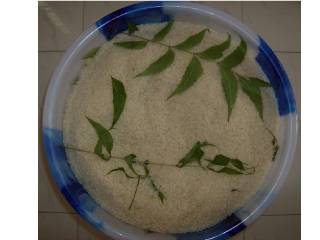
A. Dry neem leaves in the sun to ensure removal of residual water in them. Take care not to sun-burn the leaves. If neem leaves are not available, use nirgundi (Vitex nirgundo [Botanical name]) leaves. Use the same process as for neem leaves.
B. While filling a container or bag with grains, place some dry neem leaves at the bottom. Spread a paper or dry washed cotton cloth over the leaves; then, fill the container with grains. If by chance, water vapour enters the container, the paper or the cloth will absorb it.
C. While filling the container, in-between put 4-5 dry marking nuts per kg. of grains. Marking nuts are available in Ayurvedic shops. If these are not available, as an alternate use Bhimseni camphor pieces by wrapping them in paper – 1 piece for 1 kg. of grains. (Sanatan’s Ayurvedic Bhimseni camphor is available with Sanatan’s product distributors. – Compiler)
D. After the container or bag has been filled, spread a paper or cotton cloth on top and put neem leaves on it.
E. Stick a camphor piece with cellophane tape on the inside of the lid of the container. Ants and other tiny insects stay away from the fragrance of camphor. If a camphor piece is to be kept in the container, wrap it in paper and put it on the top of the grains and close the mouth of the bag firmly.
F. Fasten the lid firmly so that it is air-tight. Use a paper or plastic piece as packing to make the lid tight.
3 G 1 C 4. Keeping the grain-filled containers in the appropriate place
A. The room in which food grains are stored should not become moist during the rains. Before storing grains, clean the room thoroughly. The room should be smoked as explained above and closed for 15-20 minutes after smoking. Then, clean this room regularly and smoke it once a week.
B. Do not keep the containers on the floor; instead, keep them on a stand or a wooden plank.
C. If possible, install an exhaust fan in the store room.’
– Vaidya Megharaj Paradkar, Sanatan Ashram, Ramnathi, Goa. (17.7.2020)
3 G 1 C 5. Remedy to eliminate cockroaches
Implement any of the following remedies.

A. ‘Mix 3 parts boric powder and 1 part of wheat flour. Add little coffee powder and condensed milk to the mixture and by adding little water make small balls of this mixture; dry them well in sun. The paste can be applied to cracks and crevices. Keep balls in the corners of the room where cockroaches are found. Aroma of coffee and condensed milk will attract them and they will eat the mixture. This will stop their reproduction. Although these balls last many days, replace them as and when required.’
– Dr. Ajay Joshi, Sanatan Ashram, Ramnathi, Goa. (20.7.2020)
B. Keep a naphthalene ball at each corner. Cockroaches hate the smell of naphthalene. If naphthalene balls are kept in the open they evaporate. Hence, keep them wrapped in a paper.
3 G 1 C 6. Precautions required for the stored provisions
A. ‘Check the grains once a month.
B. Take care not to touch the grains with wet hands.
C. After Diwali, it does not rain and sunlight is also good. Dry the grains once again, treat them with smoke and store as before.
3 G 1 D. Some other remedies to protect grains from pests
The method described above for conserving dry provisions is applicable to all substances – all kinds of grains, legumes, spices, jaggery, sugar, etc.
If grains are stored with due care, they are not attacked by pests. In coastal regions such as Konkan, where the air is humid, along with the above-mentioned method of preservation, methods given ahead can also be tried. Before trying out any of the methods mentioned ahead, smoking as mentioned earlier is essential.
3 G 1 D 1. Remedies for grains which can be washed
We can use any one of the remedies mentioned ahead for rice and pulses, which can be used after washing. As we wash rice and pulses before using them in cooking, the substances used for preserving them from pests are washed away.
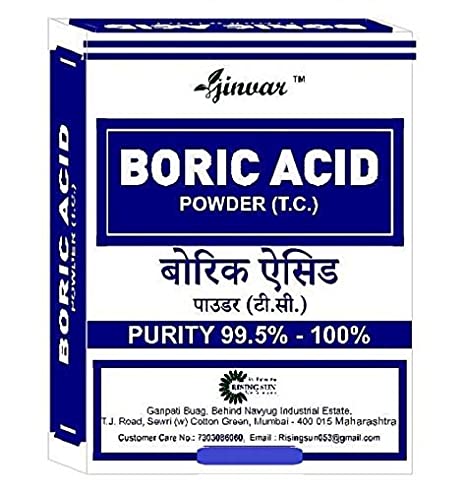
A. Boric powder : This powder must be mixed well with the grains. 10 gms. of boric powder is sufficient to be mixed in 10 kg. grains. Spread the grains on a paper, add boric powder little at a time and mix it well with the grains.
B. Mixture of natural silicate magnesium powder (shankh jeera) and lime (Calcium hydroxide) : Mix three parts of shakh jeera and one part lime and mix it with the grains in the same manner as boric powder. These substances are available in stores that sell ingredients of Ayurvedic medicines.
C. Ash : Ash is applied to pulses in particular and also to legumes such as gram, green gram, etc. Use 1 to 1.5 kg of ash for 10 kg. grains. While filling grains in the container, first layer must of ash, then layer of grains, again ash, then grains, and so on. The last layer must be of ash.
3 G 1 D 2. Remedy for grains which are used without washing
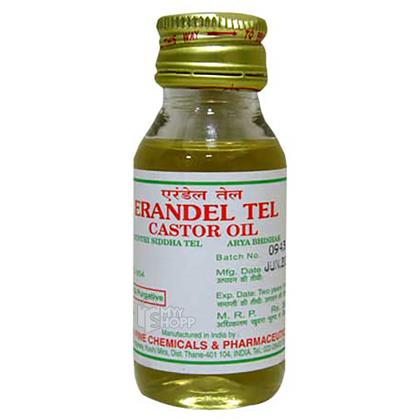
Apply castor oil to sorghum, millet and wheat. Approximately 75 ml castor oil should be rubbed to 20 kg. grains.’
– Vaidya Megharaj Paradkar, Sanatan Ashram, Ramnathi, Goa. (17.7.2020)
3 G 1 E. Some methods of preserving semolina, oil, spices, vegetables, etc.

‘Before filling the substances mentioned ahead in containers, smoke treatment of the container is very essential. The method described in Point ‘9 A 3’ with respect to storing food grains, can be applied wherever possible for the substances mentioned ahead.
1. Semolina : Keep semolina in refrigerator. It lasts for a year. If semolina is to be preserved outside, roast it and keep in an airtight container. Roasted semolina can last for approximately 6 to 7 months.
2. Beaten rice (Pohe) : Keep them in an airtight container.
3. Groundnuts : Store groundnuts with pods and as the need arises, open the pods and remove the ground nuts. Such groundnuts in the pods last for almost a year. Groundnuts sold in market last for only 2 to 3 months.
4. Sugar, jaggery and oil : Store them in airtight container. To avoid ants, fix with cellophane tape a camphor piece from inside, on the lid of the container. Use the stored oil within 6 months, otherwise it might develop foul odour.
Jaggery is moulded into big lumps (1/5/10/20 kg) and is called dhep in Marathi. A dhep can last for 4 to 5 years if preserved in a plastic bag or covered well with a sack. The broken pieces of jaggery removed from the dhep can deteriorate fast. Therefore, buy smaller dheps of jaggery and use them as required.
5. Salt : Store common salt in a china clay jar or glass jar. Fasten the lid of the jar, wrap it with cotton cloth and tie a string at the neck of the jar. Salt stored thus can last 4 to 5 years. Humidity makes salt wet. Hence, never leave salt container open. If it gets wet, dry it in sun and fill it in a dry jar.
6. Tamarind : Remove seeds and dry tamarind in the sun. Preserve by adding salt.
7. Spices : Dry them in the sun and store in an airtight container.
8. Onions, potatoes and garlic : If preserved properly, can last for 1 to 1½ year. Onions, potatoes and garlic used for storing must be fully grown (matured). Garlic must be dry. Onions and potatoes should not be piled but spread in an airy dry place. If onions and garlic are bought as bunch, they can be stored by hanging.
9. Some vegetables and leafy vegetables
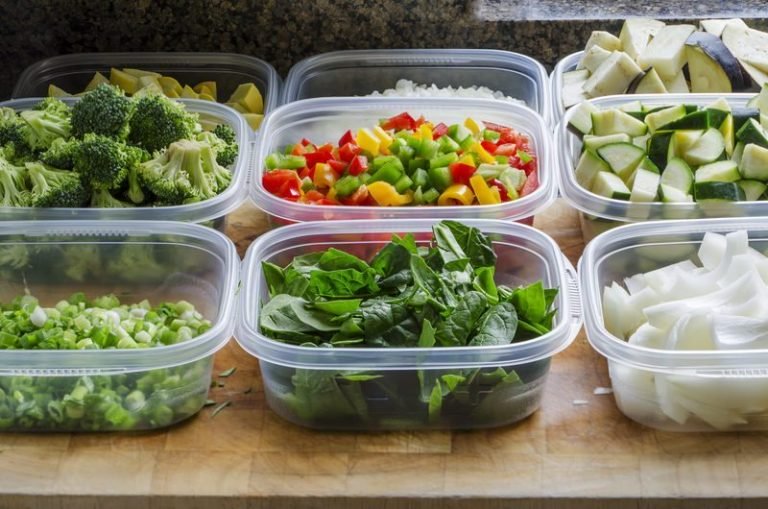
9 A. Elephant’s foot : Elephant’s foot lasts for a year. Cut required portion of elephant’s foot for making some preparation. Leave the remaining portion in a basket. It still lasts for a year.
9 B. Pumpkin : Hang pumpkin high or keep on a porous stand. Pumpkin preserved thus lasts for a year. If kept on floor it may rot.
9 C. Carrot and cucumber : Can be preserved by cutting into small pieces and drying them in sun.
9 D. Leafy vegetables : Clean and dry coriander, mint leaves, fenugreek leaves and spinach in the sun. Leaves of gram plants can also be preserved by drying.
These vegetables, if preserved in airtight containers, can last for 6 months to 1 year. These vegetables must not be tender or wet.
9 E. Tomato and raw mango : Powder of dried pieces of tomatoes and raw mangoes lasts for 1 year. This powder helps as a condiment adding sourness to a dish.’
– Mr Avinash Jadhav, Sanatan Ashram, Ramnathi, Goa. (26.6.2020)
9 F. Seeds of jackfruit
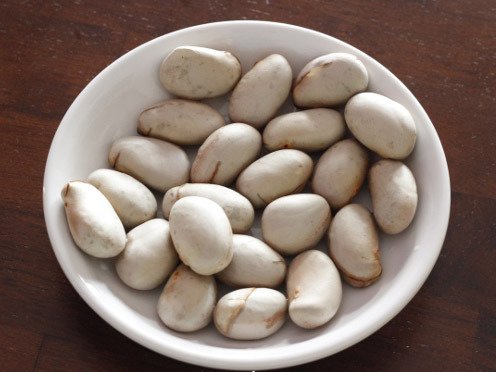
‘Traditionally, these seeds are washed, dried, smeared with soil and buried in a shallow pit (Mostly near chulha. In old days, there used to be mud floor and it would be easily possible to dig a shallow pit for storing the seeds near chulha.). Washed and dried seeds can also be stored in a refrigerator. Seeds treated thus last for 4 to 6 months. During this period, they can be removed from the pit/refrigerator, washed thoroughly, can be boiled or roasted and consumed.’
– Vaidya Megharaj Madhav Paradkar, Sanatan Ashram, Ramnathi, Goa. (17.7.2020)
To read Part 9 click here Preparation required to survive during the adverse times Part 9
Reference : Sanatan’s forthcoming Text series – ‘Preparations required to survive the adverse times’
(Copyright : Sanatan Bharatiya Sanskruti Sanstha)

 Terrace gardening a lifeline for calamitous times (Part 2)
Terrace gardening a lifeline for calamitous times (Part 2) Terrace gardening a lifeline for calamitous times (Part 1)
Terrace gardening a lifeline for calamitous times (Part 1) Activities to be undertaken daily to maintain God’s grace and to build a protective shield...
Activities to be undertaken daily to maintain God’s grace and to build a protective shield... how to improve mental strength to face a terrible situation such as a riot
how to improve mental strength to face a terrible situation such as a riot Preparation required to survive during the adverse times Part – 10
Preparation required to survive during the adverse times Part – 10 Preparation required to survive during the adverse times part – 9
Preparation required to survive during the adverse times part – 9